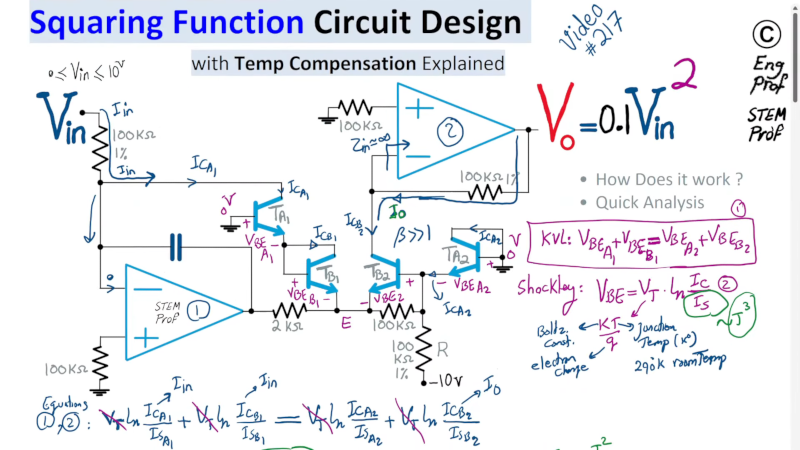An intriguing challenge has emerged for electronics enthusiasts and engineers alike: designing a circuit that squares an input voltage and outputs 10% of the result. This task, while seemingly straightforward, involves complex mathematical and engineering principles. The concept was recently explored by an engineering professor who demonstrated the solution using a combination of operational amplifiers and transistors.
The innovative approach involves taking an input voltage, such as 8 volts, and processing it to produce an output of 6.4 volts, which is 10% of the square of the input. This is achieved through a sophisticated circuit design that relies heavily on the properties of transistors and their temperature-dependent behavior.
Understanding the Circuit Design
The circuit utilizes two operational amplifiers (op amps) and a set of transistors. The key to the design is the use of a transistor array, ensuring that all transistors are matched and maintained at the same temperature. This is crucial because the behavior of transistors can vary significantly with temperature changes, affecting the circuit’s accuracy.
The mathematical foundation of the design leverages the natural logarithmic response of transistors. The principle that the sum of two logarithms is equivalent to the logarithm of the product of the numbers is central to simplifying the calculations involved. By matching transistors, many terms in the equation cancel out, streamlining the process.
The Role of Transistors
Transistors, being current devices, play a pivotal role in this circuit. The output current of the transistor circuit is calculated as the input current squared, divided by the output transistor’s collector current. This requires precise conversion of voltage to current and back, using appropriate scaling techniques.
“The transistor response, with its natural log term, is essential for this design,” the professor explained. “By using matched transistors, we can ensure consistent performance across different conditions.”
Historical Context and Applications
Squaring a voltage is not a novel concept but has significant implications in the realm of analog computing. Historically, analog computers have relied on such mathematical operations to perform complex calculations before the advent of digital technology. The ability to accurately square a voltage can enhance the capabilities of modern analog systems, offering potential advancements in fields such as signal processing and control systems.
According to industry experts, the resurgence of interest in analog computing, driven by its efficiency in certain applications, makes this development particularly timely. The precision offered by this circuit design could lead to improved performance in systems where analog computation is preferred.
Expert Opinions and Future Prospects
Experts in the field of electronics engineering have lauded the innovative approach, highlighting its potential to simplify complex operations in analog circuits. The use of op amps and transistors in this manner could pave the way for new applications and improvements in existing technologies.
“This development represents a significant step forward in analog circuit design,” said an industry analyst. “It opens up new possibilities for engineers looking to optimize performance in various applications.”
Looking ahead, the principles demonstrated in this circuit design could inspire further research and innovation. As technology continues to evolve, the integration of such advanced techniques into practical applications will be crucial for maintaining competitive advantages in the electronics industry.
For those interested in delving deeper into the technical aspects, the professor’s video provides a comprehensive walkthrough of the math and engineering principles involved. Additionally, resources are available for those needing a refresher on Kirchhoff’s Current Law (KCL) and other foundational concepts.
In conclusion, the challenge of squaring a voltage with precision has been met with an elegant solution that underscores the enduring relevance of analog computation in today’s digital world. As engineers continue to push the boundaries of what is possible, such innovations will undoubtedly play a pivotal role in shaping the future of technology.
